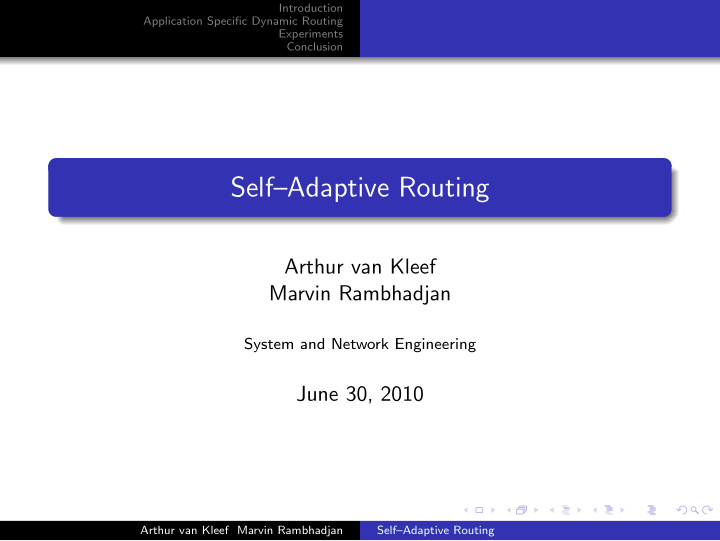



Introduction Application Specific Dynamic Routing Experiments Conclusion Self–Adaptive Routing Arthur van Kleef Marvin Rambhadjan System and Network Engineering June 30, 2010 Arthur van Kleef Marvin Rambhadjan Self–Adaptive Routing
Introduction Introduction Application Specific Dynamic Routing Existing Protocols Experiments Control Plane Conclusion Research Questions Introduction Network management involves complex tasks. Congestion Control Load Balancing, Rerouting Quality of Service i.e. Voice and Video Provisioning Resource Reservation Arthur van Kleef Marvin Rambhadjan Self–Adaptive Routing
Introduction Introduction Application Specific Dynamic Routing Existing Protocols Experiments Control Plane Conclusion Research Questions Existing protocols Review of existing protocols based on adaptivity Protocol Layer Capabilities OSPF 3 Path Cost BGP 3 Local Pref, MED, Next-Hop, AS-Path MPLS(-TE) 2.5 Explicit LSP’s PBB(-TE) 2 Service and Trunk coupling STP 2 Path Cost, Priority The control plane becomes more complex by adding new protocols and protocol extensions. Arthur van Kleef Marvin Rambhadjan Self–Adaptive Routing
Introduction Introduction Application Specific Dynamic Routing Existing Protocols Experiments Control Plane Conclusion Research Questions Control Plane The control plane performs the following functions: Control Connections Disseminate connectivity information Calculate optimal path Software programs are good at handling complex tasks. Separate forwarding plane from control plane (ForCES). Arthur van Kleef Marvin Rambhadjan Self–Adaptive Routing
Introduction Introduction Application Specific Dynamic Routing Existing Protocols Experiments Control Plane Conclusion Research Questions Research Questions What is the architecture of a network that supports a software control plane? If the control plane becomes software, what is the general pattern of the programs that implement routing and network management? Arthur van Kleef Marvin Rambhadjan Self–Adaptive Routing
Introduction Application Specific Dynamic Routing OpenFlow Experiments Network Control Program Conclusion OpenFlow OpenFlow Operation 1 Packet sent to switch 2 Switch passes packet to controller 3 Control decides action 4 Install flow entry 5 Packet forwarded to the host Arthur van Kleef Marvin Rambhadjan Self–Adaptive Routing
Introduction Application Specific Dynamic Routing OpenFlow Experiments Network Control Program Conclusion OpenFlow Tuple Flows describing traffic. Ingress Ethernet Ethernet Ethernet VLAN VLAN IP IP IP IP TCP TCP Port src dst type id prior- src dst proto ToS UDP UDP ity src dst port port Actions Send to controller Forward Flood Drop If switch does not have a flow–entry that matches a certain packet header then it forwards a packet to the controller. Arthur van Kleef Marvin Rambhadjan Self–Adaptive Routing
Introduction Application Specific Dynamic Routing OpenFlow Experiments Network Control Program Conclusion Network Control Program Reference Desired behavior Controller Controller responsible for taking forwarding decisions System Programmable network infrastructure Sensor Monitoring for switch statistics Arthur van Kleef Marvin Rambhadjan Self–Adaptive Routing
Introduction Test Environment Application Specific Dynamic Routing Control Program Components Experiments Control Program Operation Conclusion Examples Test Environment Resources were limited, so can we virtualize OpenFlow networks? Hosts User Mode Linux OpenFlow Switches User Mode Linux + Open vSwitch Connections Virtual Distributed Ethernet (VDE) Controller NOX OpenFlow Controller Large topologies, runs on moderate hardware, flexible Arthur van Kleef Marvin Rambhadjan Self–Adaptive Routing
Introduction Test Environment Application Specific Dynamic Routing Control Program Components Experiments Control Program Operation Conclusion Examples Control Program components Control Program consists of different components that: Maintain network topology in a graph Track the location of end hosts Monitors traffic and link utilization Calculates paths between source and destination Shortest Path All possible paths Installs flow entries on OpenFlow switches Arthur van Kleef Marvin Rambhadjan Self–Adaptive Routing
Introduction Test Environment Application Specific Dynamic Routing Control Program Components Experiments Control Program Operation Conclusion Examples NCP Operation 1 Receive packet in event 2 Learn ethertype 3 Locate destination node in the topology 4 Add or consider active policy 5 Calculate path to destination 6 Return flow entry Arthur van Kleef Marvin Rambhadjan Self–Adaptive Routing
Introduction Test Environment Application Specific Dynamic Routing Control Program Components Experiments Control Program Operation Conclusion Examples Example: Case Network OF N Open vSwitches Host N network hosts Virtual Distributed Switches Arthur van Kleef Marvin Rambhadjan Self–Adaptive Routing
Introduction Test Environment Application Specific Dynamic Routing Control Program Components Experiments Control Program Operation Conclusion Examples Example: Single Traffic Flow One traffic flow Arthur van Kleef Marvin Rambhadjan Self–Adaptive Routing
Introduction Test Environment Application Specific Dynamic Routing Control Program Components Experiments Control Program Operation Conclusion Examples Example: Extra high priority traffic flow Another traffic flow with a higher priority Arthur van Kleef Marvin Rambhadjan Self–Adaptive Routing
Introduction Test Environment Application Specific Dynamic Routing Control Program Components Experiments Control Program Operation Conclusion Examples Example: Link Failure Two traffic flows with a link down Arthur van Kleef Marvin Rambhadjan Self–Adaptive Routing
Introduction Test Environment Application Specific Dynamic Routing Control Program Components Experiments Control Program Operation Conclusion Examples Scalability of Programmable Networks FlowVisor is a transparent proxy between OpenFlow switches and controller(s). Multiple FlowVisor controllers can be added to balance the load between the controllers. The network can be “sliced” and the control is delegated to a controller and are based on the following criteria: Layer Options 4 src / dst TCP or UDP, ICMP code 3 src / dst IP address, IP Protocol, IP TOS 2 src / dst Ethernet address, VLAN 1 Physical switch port Arthur van Kleef Marvin Rambhadjan Self–Adaptive Routing
Introduction Application Specific Dynamic Routing Experiments Conclusion Conclusion OpenFlow provides an architecture that support separation of the control plane and the forwarding plane. The general pattern of the software control plane is a feedback control loop. The test environment presented is very useful for OpenFlow experiments. Arthur van Kleef Marvin Rambhadjan Self–Adaptive Routing
Introduction Application Specific Dynamic Routing Experiments Conclusion Questions ? Arthur van Kleef Marvin Rambhadjan Self–Adaptive Routing
Recommend
More recommend